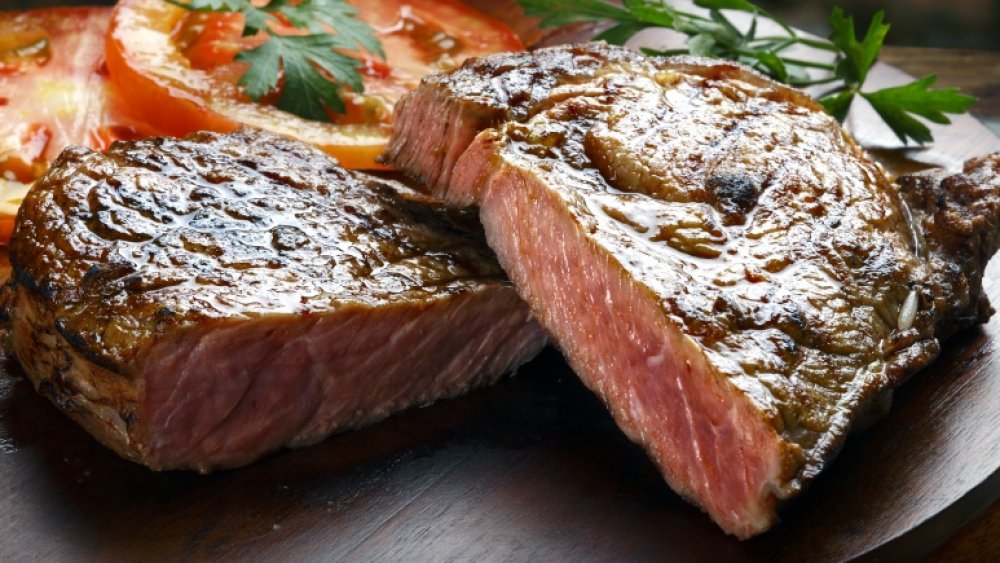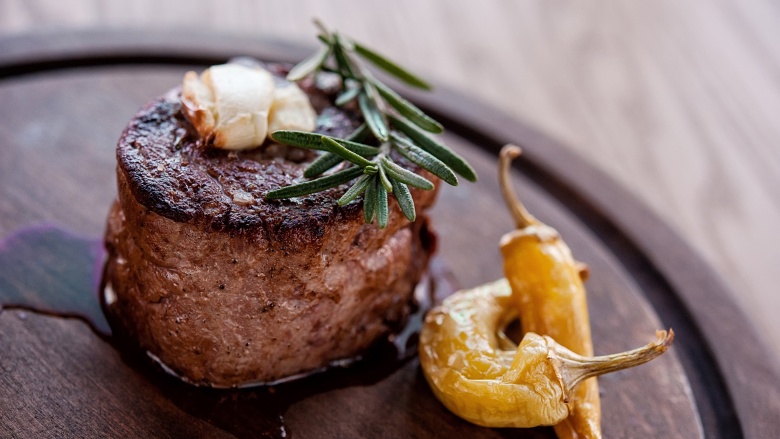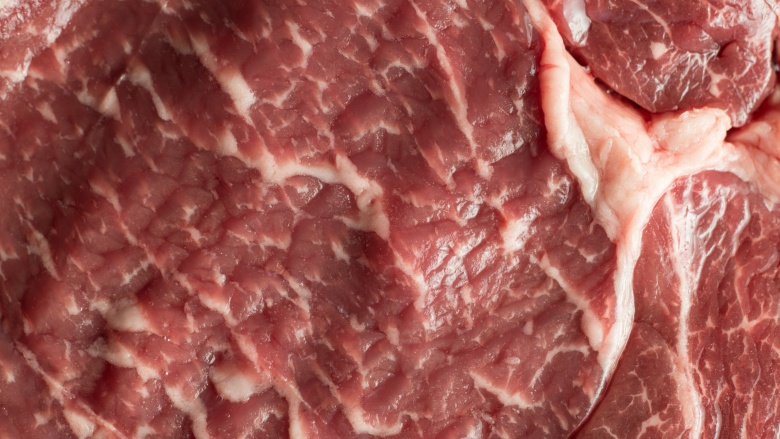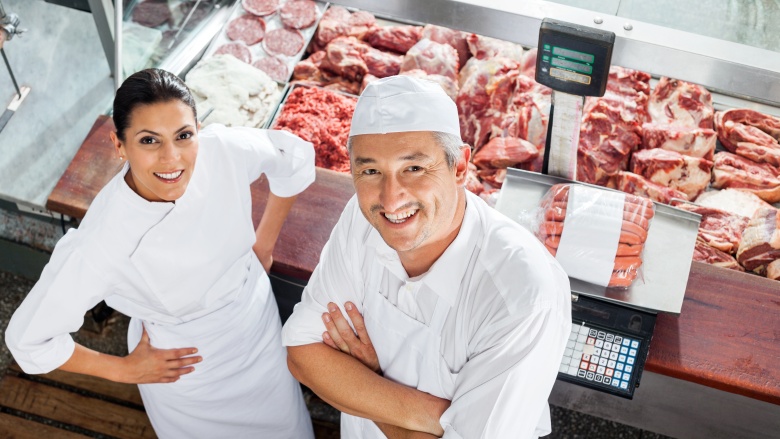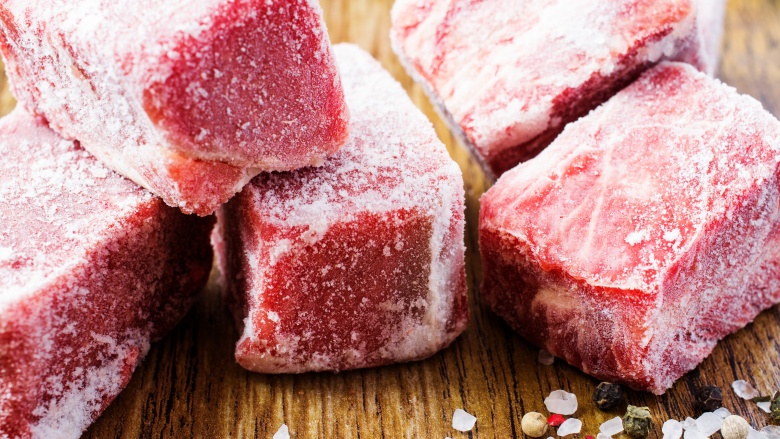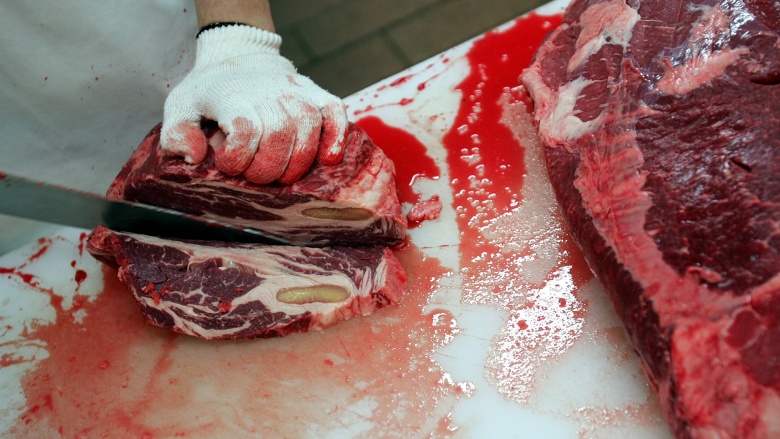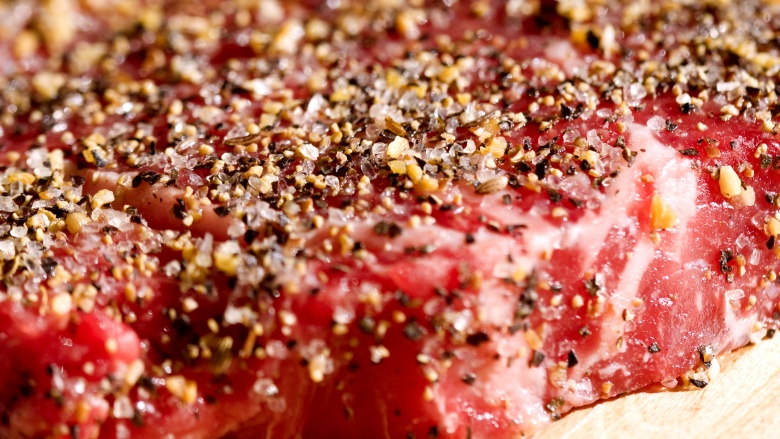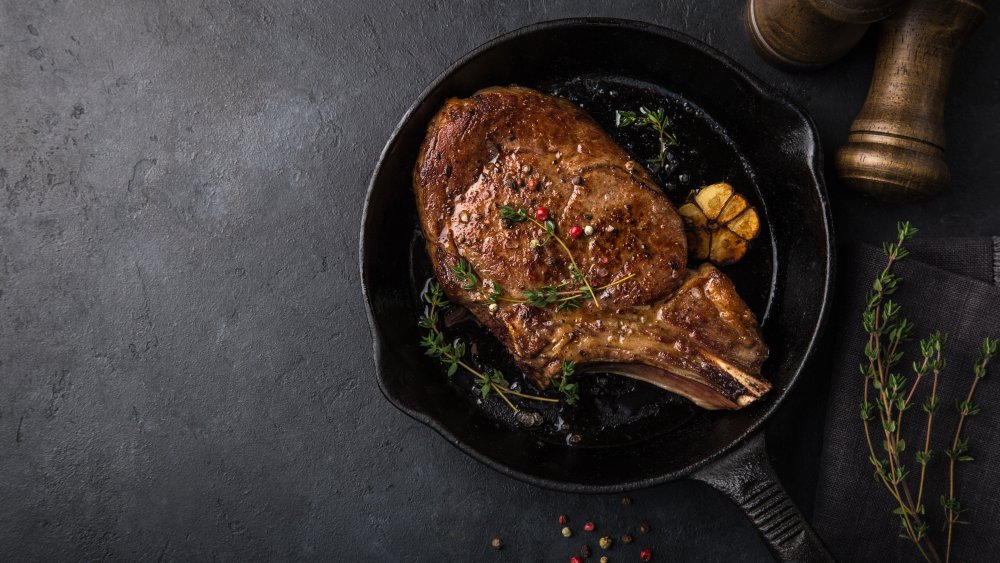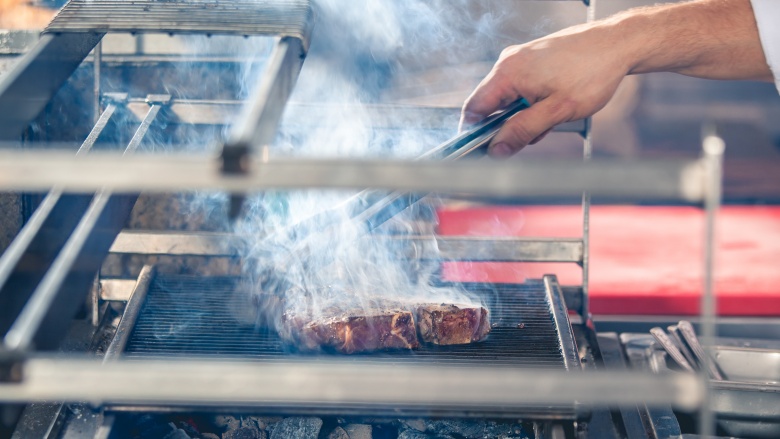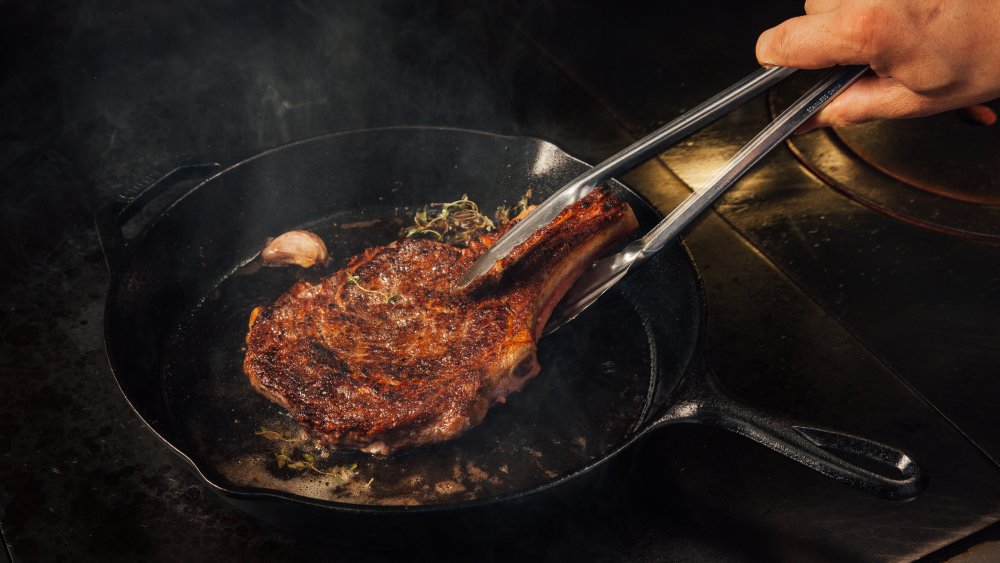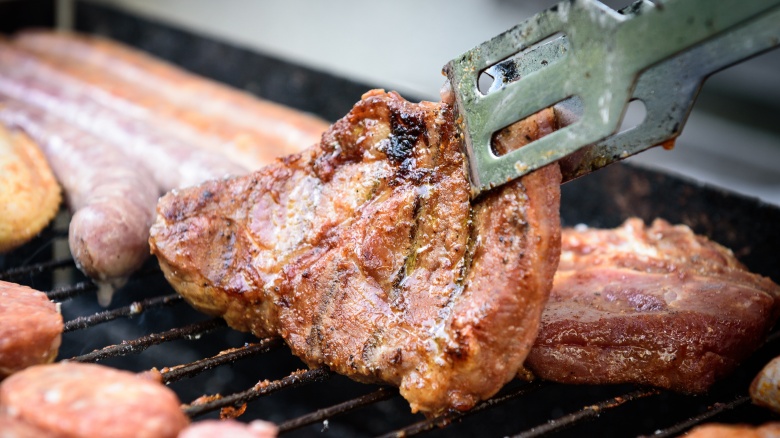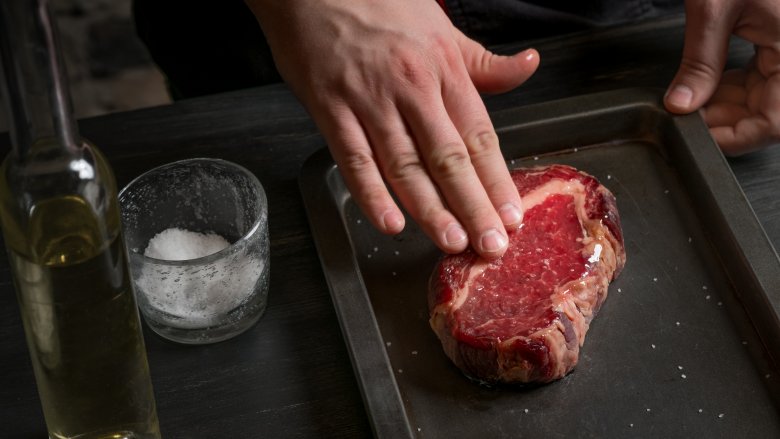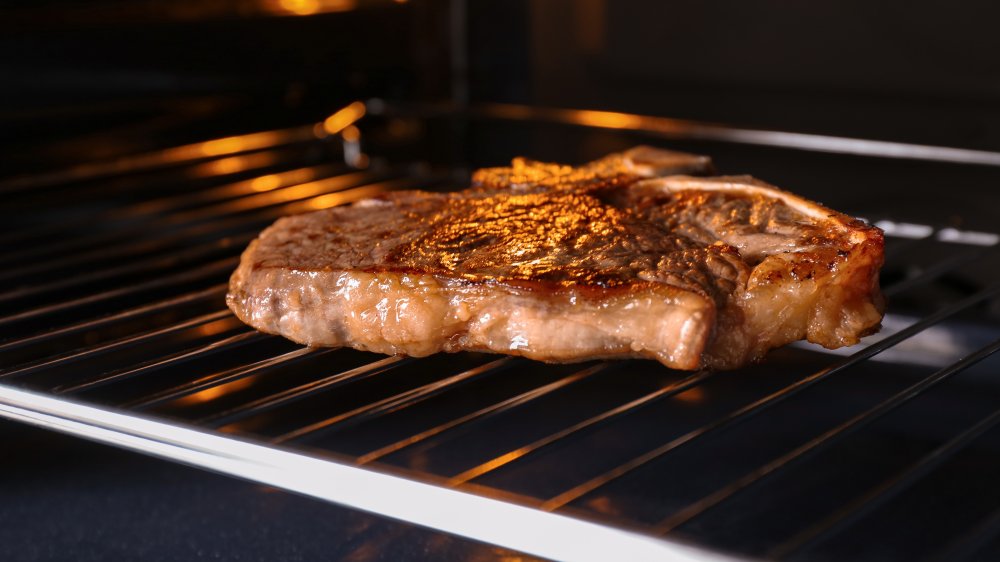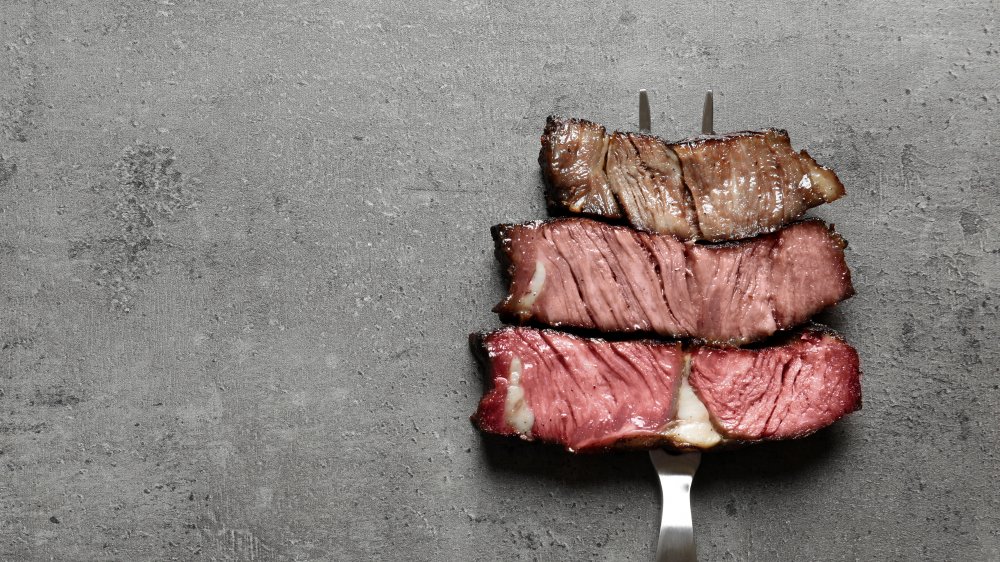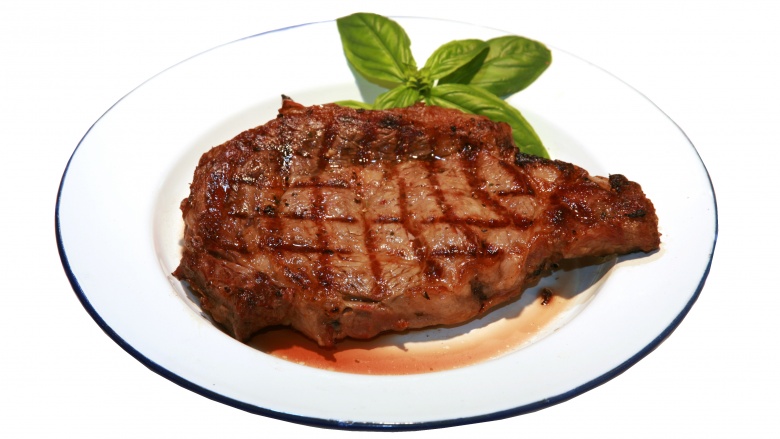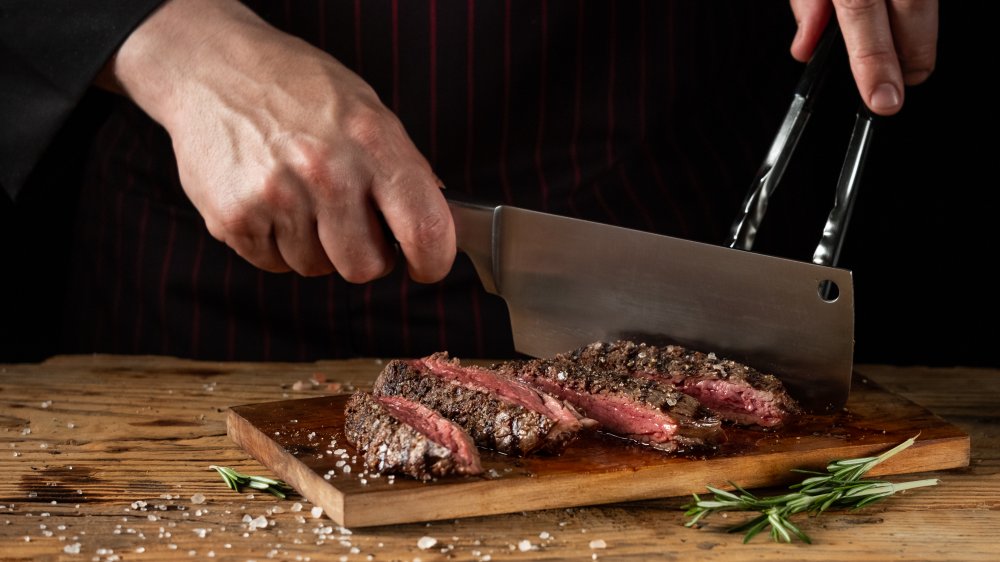Mistakes Everyone Makes When Cooking Steak
When cooked correctly, steak is the king of meats. It's big and bold, and it has a way of dominating any meal in the best way. Although there are a few tricks to make cheap steaks taste expensive, steak is also usually pretty pricey, especially when you go for options like thick-cut ribeyes, New York strips, or filet mignon cuts from the tenderloin. Things can get even more expensive when you graduate from buying regular beef at the grocery store to grass-fed beef, enormous bone-in tomahawk steaks, or specialty dry-aged options from the butcher shop.
When steak is cooked to medium-rare temperatures, it's absolutely worth the high price tag. Unfortunately, it's easy to make a mistake or two that can ruin your investment, turning a perfectly good steak into an underwhelming meal. But don't despair: We know a few tricks to save your steak from turning into a dry, tough, unappealing hunk of meat. Read on to find out how to cook steak as good as your favorite steakhouse restaurant.
Buying the wrong kind of steak
There are lots of things that can go wrong to ruin your steak dinner: you can undercook the steak, overcook the steak, under season it, overseason it, have a few too many drinks and forget about it entirely ... the list goes on. But don't worry about all that just yet. In order to eat a good steak, you first have to buy a good steak.
While it's easy to empty your wallet on the more fashionable cuts, like tenderloin or New York strip, with a little knowledge, you'll find that other bits of the cow are super tasty without the premium price tag. So if you want steak but struggle with the price, instead of those classic, but expensive cuts, try throwing a hanger steak, a tri-tip, or one of these others on the grill. Since they are likely to have more connective tissue or naturally be a little tougher, they may require a little more attention to cook just right, but if you make the effort, you definitely won't be sorry.
Choosing a lean cut of meat when buying steak
When given a choice between lean and fatty, most people will err on the side of lean. This is understandable if you're looking to cut calories, but otherwise you're probably better off buying a smaller, fattier piece of meat. This is because the fat often adds flavor and juiciness to the steak, especially when the fat is "marbled" throughout the steak.
Good marbling is an indicator of high-quality meat, and it is one of the things USDA inspectors look at when deciding on the rating. An even distribution of fine marbling is the best choice, and will earn the meat a USDA rating of "Prime" for the best cuts (usually sold in hotels and restaurants), "Choice" (good quality, less marbling), and finally "Select" (leaner cuts that have a little less flavor). If you go below "Select," you're getting into generic, store-brand, plastic-wrapped meats, and although they offer financial advantages for the budget-conscious consumer, you'll probably incur net flavor losses if you go this route.
Buying your steak at the wrong place
While the USDA rating system is an easy shortcut to choosing a great piece of cow, there is really no substitute for years of experience to help you get the most for your money. That isn't to say you should struggle through years of hit-and-miss meals before you earn that experience for yourself; this is a reminder that although supermarkets and plastic-wrapped meat are convenient, there are other places you can go for your meat where good advice is included in the price per pound. So instead of just looking for a USDA label, trying to assess which fictional farm sounds more authentic, or simply poking at the meat through the cellophane, you can actually talk to someone to find the cut that suits your needs and learn something new along the way.
Good places to go are butcher shops, farmers markets, or the occasional supermarket with an actual in-house butcher (not just a local teenager wearing a bloody apron). The advice they can provide goes beyond the immediate questions like flavor and price, and can include information on the origin of the meat like where the cow was raised, its breed, whether it was grass-fed or corn fed, and so on. That way, you can go home actually knowing what you're about to throw on the fire, rather than accepting the prepackaged fiction that can hide a whole host of culinary and ethical sins.
Letting your steak warm up
So you bought your steak on Monday and plan to eat it on Wednesday, and in the meantime it's sensibly sitting in the fridge waiting patiently. With many of the other animal products that you probably have in your refrigerator or freezer, you'll typically want to get them to room temperature before you cook them. With things like chicken and fish, which either need to be thoroughly cooked for safety, or just evenly cooked throughout, bringing them up to room temperature improves your odds of getting it right. But when it comes to steak, which neither needs to be cooked thoroughly, nor evenly, having the meat start out on the cold side will work in your favor.
Regardless of how you like the inside of your steak done (we'll get to that later), you probably like the outside to be dark brown and lightly charred. If you also like the inside to be anywhere south of medium, you'll probably go with the standard cooking practice of throwing it onto an insanely hot grill or pan for a couple minutes. If you time it right, this will sear the outside to crispy perfection without letting the heat do much to the inside. In the case of a rare steak, this can require as little as one minute per side, depending on the thickness. The internal temperature of a rare steak is around 125 degrees, so if you're cooking it from room temperature, say 72 degrees, the grill only needs to raise the internal temperature 53 degrees to hit that mark. But if you leave your steak in the fridge at around 35 degrees, and throw it on the grill at that temperature, the grill now has to raise the inside temperature 90 degrees to get to the same place. This achieves two things: the extra time required to heat the steak to the ideal temperature makes it easier for you to hit the window of perfect doneness, and it also gives the outside a little extra time for the Maillard reaction to take effect, which uses the transformation of amino acids and sugars at high temperature to produce that mouth-watering grilled flavor you're totally thinking about right now.
If you suddenly have a (very understandable) desire to cook steaks for dinner but only have frozen steaks on hand, fear not. According to Cook's Illustrated, cooking steaks straight from frozen is better than thawing them before cooking because it results in more retained moisture and less overcooking. However, since the process works best when you freeze the steak in a specific way, you may still prefer to plan ahead and cook them straight from the butcher instead.
Your steak is too wet
There are two ways your steak gets wet: it either comes out of the package covered in the natural glistening steak runoff comprised of myoglobin and water (it's not blood, FYI), or you decide to rinse it under the tap. Rinsing any meat is just a bad idea because while you think you're removing harmful bacteria and making the world a safer place for your children, you're actually spreading it around your kitchen and into places you'll never think to hose down with bleach. If you're still not sure, you can take the USDA's word for it.
Since you won't be rinsing your meat anymore, there's just the myoglobin left to consider. Those myoglobin-y juices that look so much like blood aren't really a problem. However, if they're on the steak when you throw it on the grill, they'll get in the way of the Maillard reaction. The Maillard reaction really gets going around 300 degrees, which is easily achieved by most any grill. However, if the surface of your steak is wet when you start to cook it, the temperature of the steak will plateau at 212 degrees until the water boils off, and only then can it head above the 300-degree threshold required for exquisite flavor to appear. But since the steak is also cooking while it's sitting at 212 degrees boiling off water, there won't be much time left for making flavor when it finally dries itself out. Give your steak a few good blots with a paper towel before cooking to ensure this isn't a problem.
Not seasoning your steak enough
It goes without saying that you should season your steaks before you cook them, but are you seasoning them enough? Maybe you give them a light sprinkling and call it good. You'll find that although the light sprinkling seemed like just the right amount on the surface of the meat, it totally failed to take into account the iceberg nature of steaks in general: most of the meat is below the surface. When you season your steak, you should apply a generous helping of kosher salt (and pepper, if you like) and rub it into the surface. It's fine, you can't really go wrong with salt and pepper.
If you're feeling adventurous, you can take it much further. There are endless recipes for steak rubs and marinades to get your mouth watering, but a simple one to start with is made simply by adding garlic powder and onion powder to salt and pepper. Be warned that using exotic rubs and marinades (like these creative ones) might overpower the more subtle flavor of the meat. But if you only have access to a so-so cut, a sneaky rub might make all the difference to your meal.
Using the wrong pan to cook steak
Steak is one of those ingredients that benefits from quick, high-heat cooking, which isn't a problem if you're cooking outside on the grill. When you bring the cooking inside, you need to consider which pans in your arsenal can handle the high heat. No matter what you do, don't reach for a nonstick pan when cooking steak. According to Good Housekeeping, overheating a Teflon-coated pan causes the coating to release toxic chemicals. Although you can't see it happening, the coating starts to break down at a molecular level, releasing potentially carcinogenic gasses into the environment.
Nonstick pans also can't go in the oven, which you might need to use to finish cooking thicker steaks. Much better to use a pan that's good at searing and can also be used in the oven, like stainless steel or cast iron. These pans can handle high heat temperatures — both on the stovetop and in the oven — and they hold heat well, ensuring an even sear.
Using oil with a low smoke point to cook steak
You're cooking a couple of classy steaks that cost you most of a day's wages, so you're going to do it right and cook them in some classy extra virgin olive oil, right? Wrong! Extra virgin olive oil might be the best choice for a lot of cooking, but it isn't cut out for the heat. Throw it on a nice temperate salad or bake it in a cake, and it's right at home. But throw it on a grill at 500 degrees and it will cut and run and leave bad flavors in its wake. Extra virgin olive oil has a low smoke point of around 320 degrees, and butter is a bit higher at around 350 degrees. If you use either of these, or any other oil with a similar smoke point, the oil will start smoking (obviously). Apart from the aforementioned bad flavors the oil will leave behind, the smoke may contain toxic chemicals and could leave carcinogenic compounds on the meat.
Better choices for grilling or frying steak include peanut oil, canola oil, and extra light olive oil, all of which have smoke points above 400 degrees. In general, the lighter the color of the oil, the higher its smoke point. The more highly refined oils also do better at high temperatures, since the refining process removes many of the combustible compounds. Choosing the right oil will help you make tastier steaks, and when you fry steaks inside in the middle of winter, you won't turn your house into a really big meat smoker.
Not getting a great sear on steak
Some people say that serving a steak with perfect, diamond grill marks is the way to go, but we disagree. Grill marks make the steak look pretty, but it doesn't ensure it tastes as good as it can. Better to skip the grill marks and get a hard sear on the steak instead. You see, the exterior of a steak will brown and caramelize when it's exposed to high heat because of something called the Maillard reaction, a chemical reaction that happens between amino acids and sugars. The result is a pleasantly crispy crust and the production of hundreds of flavor compounds that make the steak taste better.
The best way to get this sear is to use a cast-iron skillet. These pans don't have any gaps like a grill grate, so the steak will be exposed to even heat on its entire surface. Make sure to let the skillet preheat until it's smoking hot before adding a splash of cooking oil. Then, cook the steak for three to four minutes — undisturbed — before flipping it over and searing the other side. If you want to get a better sear using the grill, make sure to move the steak around frequently to give the surface more exposure to the grill grates. We like to turn the heat down to medium-high and flip the steak every minute until it reaches the proper internal temperature.
Leaving the steak alone
Common wisdom would have you fling the steak onto the grill, and flip it once halfway through the cooking time. And it would be hard to make a claim that this method doesn't work, because a million tasty steaks have been cooked this exact way. But just because it works doesn't mean it's the best way. This method is trying prevent unnecessarily removing the steak from the heat. However, according to the Food Lab, extra flipping might be just what the doctor ordered. Frequently flipping the steak actually helps to more evenly cook the steak. The brief period of cooling lets excess heat escape and prevents the meat near the surface from overcooking. It also helps the meat cook faster, because although there is a small amount of heat loss, the temperature doesn't get down far enough for the cooking process to stop. Thus, flipping about every 30 seconds effectively simulates cooking the meat from both sides at once and can shorten cooking times.
Despite the advantages in cooking speed and even cooking, the Food Lab admits that this technique doesn't change the flavor much from the single flip method. So if you're engaged in a particularly interesting conversation or if you would rather give your attention to a certain dinner guest than a charring hunk of meat, you won't harm your reputation by reverting. But if you want to faster food or just an excuse to stop talking to a certain dinner guest for a few minutes, start flipping.
Using the poke test to decide if your steak is done
If you've ever had a conversation about cooking steak, you've probably heard of the poke test. According to this method, you can tell whether a steak is rare or well-done simply by poking the steak with your finger and comparing its squishiness with different parts of your hand or face or whatever. The additional benefit of this method is that you avoid puncturing the steak with a meat thermometer and releasing the juices.
There are two things immediately wrong with this. First, the difference in temperature between a medium rare steak and a rare steak is less than 10 degrees. The experience necessary to accurately judge doneness by poking with your finger is such that your average occasional griller is unlikely to ever achieve any level of accuracy with it. Second, a steak is not a water balloon! Sure, poking it with a meat thermometer will release some juice, but unless you've already severely messed up and cooked the steak virtually dry, the amount of liquid lost won't be noticeable to anyone who isn't mechanically designed to measure such things. The only real and honest way for an average, non-professional steak-flinger to accurately distinguish a medium steak from anything else is with a decent meat thermometer. Besides, a meat thermometer looks totally pro, and your guests actually don't want you poking their food with your fingers just before you slap it on their plates.
Not finishing steak in the oven
You can skip this step for steaks that are an inch or thinner, but using the oven is a great way to cook thick steaks. Cooking a steak over direct heat on the grill or in a preheated skillet will cook the steak from the outside in, caramelizing the exterior as the heat slowly creeps towards the meat's center. But it takes a long time to cook a thick steak all the way through, and you can end up burning the outside before the inside finishes cooking. Stovetop searing also doesn't ensure the steak will cook evenly, as the meat is only exposed to heat from the bottom.
Instead, use the oven's overall heat to finish cooking your steak. You'll still want to give the steaks a hard-and-fast sear to develop that gorgeous crust, so go ahead and sear the steak for three to four minutes on the first side. Then, flip the steak over and pop it into 450 degree Fahrenheit oven for about 10 minutes. The pan will be hot enough to sear the second side, and the gentle heat of the oven will cook the steak through while keeping it nice and juicy. If you're using a probe thermometer, even better: You'll know the exact moment when you should remove the steak from the oven.
Overcooking steak
Overcooking steak is the best way to end up with a dry, tasteless hunk of meat. We know that some people prefer their steaks cooked to well-done temperatures, but we'd urge you to reconsider. What makes an overcooked steak so bad? According to Amazing Ribs, meat dries out as it cooks because of chemical and physical reactions that occur inside the meat. The muscle fibers and connective tissues contract, squeezing out moisture, and the proteins begin to denature, making the meat tough and dry. By the time the meat reaches 155 degrees Fahrenheit, it doesn't contain enough moisture to taste juicy, and the fibers have become tough.
The best way to ensure your steak won't accidentally overcook is to use a thermometer. Probing the meat will allow you to know the exact internal temperature without having to cut into it. If you happen to be cooking for someone who insists they need their meat well-done, buy an inexpensive steak like round or rump steak. They won't be able to taste the quality of expensive meat, so you may as well save some money if you're going to purposely ruin a steak.
Not letting your steak rest
Steak is pretty awesome, and you can't be blamed for wanting to immediately shove it down your throat once it's off the heat. This is a mistake. As meat is cooked, the fibers start to shrink, and any water they contain is squeezed out and into the spaces between. The higher the temperature the meat achieves, the greater the effect. If you cut into the meat immediately after it comes off the grill, much of that liquid and — the juiciness it would have been responsible for — will run out onto your plate. However, if you cover the meat in foil and let it rest for 10 to 15 minutes, the fibers in the meat will have a chance to relax and let some of the juices back in.
Cooking a quality steak can be a stressful experience for you as well as the steak, what with all the heat, spitting oils, charring meat, and short cook times. So if you don't give yourself a chance to relax, sip a glass of wine, and anticipate the pleasure to come, you will have turned the chance to eat like a king into a nothing more than a medieval chef simulator.
Slicing steak incorrectly
If you do everything correctly, you can still mess up your steak at the last moment. Luckily, this mistake is really easy to avoid so long as you pay attention to a few details. It all has to do with something called the grain, long muscle fibers in meat that run parallel to each other. If you slice with the grain, you'll end up with a lot of long muscle fibers that can be hard to chew. That means your steak will taste chewy, even if it was cooked perfectly!
Instead, position your knife perpendicular to the grain, so it forms a "T" with all those tiny lines. By slicing against the grain, you'll shorten those muscle fibers and make them easier to chew, resulting in a more tender-tasting steak. It's sometimes difficult to identify the grain, especially when it seems to change directions. You may need to switch directions halfway through cutting the steak, but it will be worth it when you take a bite.
